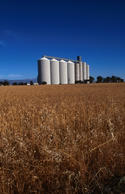Wheat should be harvested early enough to prevent shattering, pre-harvest sprouting and bird damage, but late enough for the grain to have dried.

Harvesting in South Africa generally starts when the moisture content of the wheat is about 16%, but may be as low as 13% when the wheat will be stored.
Varieties that tend to lose grain, referred to as shattering, should be harvested earlier and be dried artificially. Wheat harvesting starts from November December in the winter rainfall areas and later in the summer rainfall areas.
How to Harvest Wheat

Average Production of Wheat

Classification of Wheat
Wheat in South Africa has been traditionally classified into four grades according to the protein content, hectolitre mass and falling number, which are all indicators of the baking quality of the wheat. Hectolitre mass is the weight of a standard volume of wheat. While the falling number is a measurement that detects the effect of enzymes on wheat quality.
To qualify as B1, the wheat used to have a minimum protein content of 12%, hectolitre mass of 77 kg/hectolitre and falling number of 220 seconds, with the requirements being downscaled through B2, B3 and B4 to only 8% protein, 70 kg/hectolitre and 150 seconds for utility grade.
A new grading system, introduced in 2019, is used to improve wheat production profitability. Based on this, a new super grade has been created for wheat with a protein content higher than 12% to accommodate wheat produced under irrigation. The protein content for traditional grades will be adjusted downwards from 12% to 11,5% for Grade B1, from 11% to 10,5% for Grade B2 and 10% to 9,5% for Grade B3.
The price difference between the grades has also been adjusted downwards, with the difference between B1 and B2 shrinking to 1% in comparison with the past when it was as large as 4%. The price difference between B1 and B3 will then shrink to only 3%.
Storage of Wheat

Whereas resource-poor farmers may store their wheat in various types of containers, ranging from conventional bags to underground pits, the ideal is to get the wheat in airtight grain stores as soon as possible to reduce post-harvest losses caused by fungi, moisture or parasites.
In South Africa, farmers may use grain storage bags to reduce losses while waiting for transport to collect the wheat, while on-farm silos or cooperative silos may be used to store the wheat for longer periods.
Storing wheat in silos is easier said than done, since the wheat has to be stored at the right humidity and temperatures to prevent it from rotting. It also needs to be protected from rodents and other pests that may cause losses.